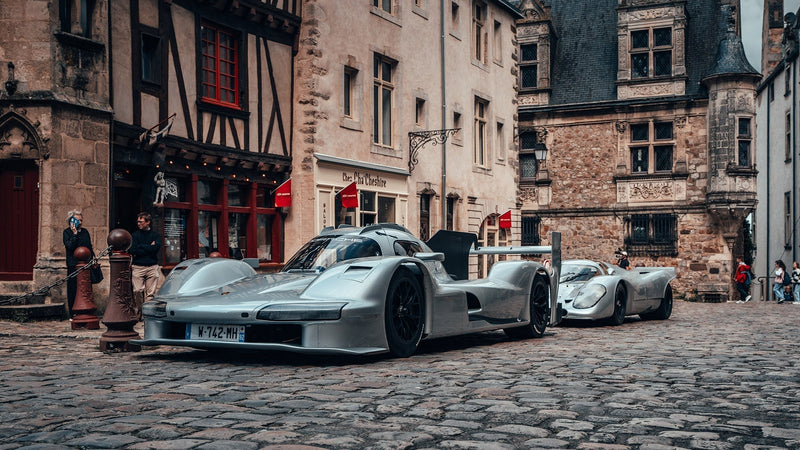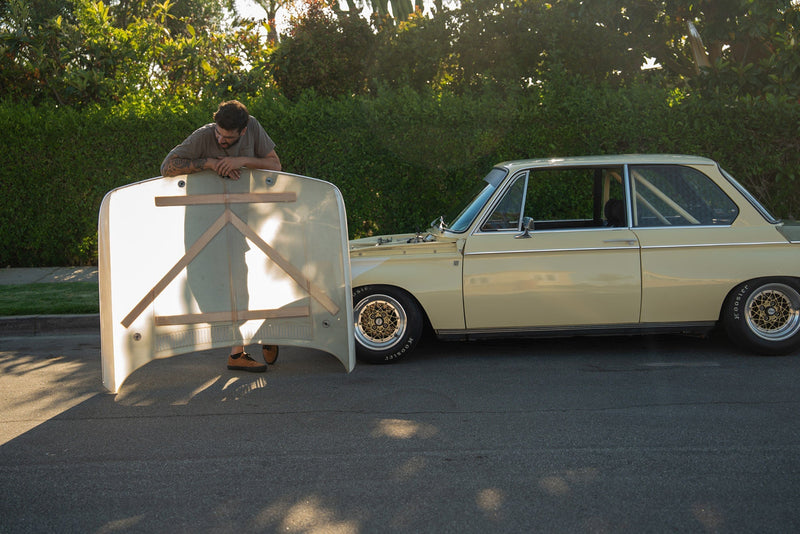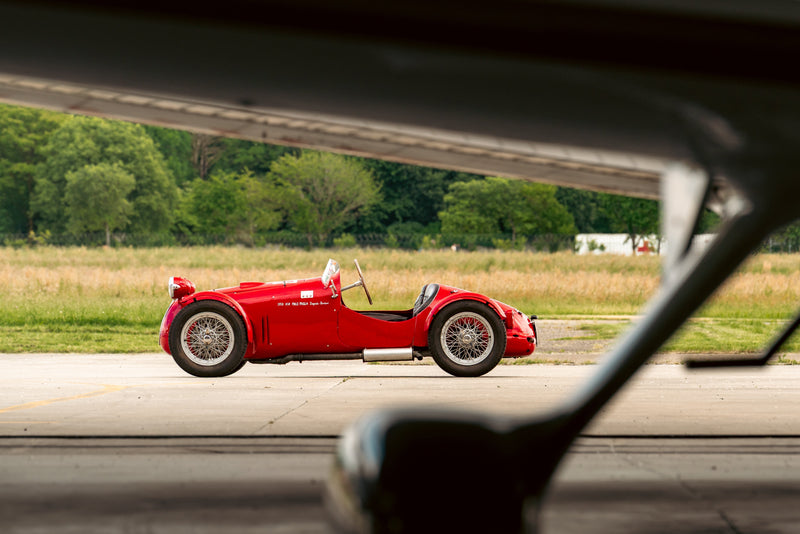Imagine the challenge of staying engaged and interested in motorsport once you've reached that peak. What could ever possibly live up to that? For Érik Comas, the answer was obvious: The legendary Lancia Stratos has kept the F1 blooded French driver satisfied behind the wheel.
We recently sat down with Erik to get the full story behind where he's been, where's he's going, and why he fell in love with the Bertone wedge.

Andrew Golseth: Érik, you’ve had quite the motorsports career—how did it all begin?
Érik Comas: My father was a good mechanic and opened a small garage in 1969 in the city of Romans, the French capital of shoes. Quite quickly, one of my father’s main customers was a Mr. Charles Jourdan, who founded the luxury shoe brand Charles Jourdan.
He came to the shop needing his carburators tuned, then he bought an Alpine, then another Alpine, then a 2.7 Porsche, then a Dino, he was just collecting cars, never selling the other ones. At the end, 80 percent of my father’s income was coming from Jourdan’s collection.
I wish I had those cars in my garage now. They were all the best cars of the time. This collection, this is what gave me my first taste of sportscars—Mr. Charles Jourdan’s collection.


AG: So, how did you get involved in motorsports?
ÉC: One of my father’s mechanics was racing go-karts, which wasn’t really popular like it is now. It was quite small in 1976. I tried it one day and it was a total revelation.
I told my father it’s what I wanted to do, and he said I could but he did not want me to do competition. I told him there was no point if I couldn’t compete but he was not flexible on this, he refused to let me race in competition.
I waited until I was 18 years old to start racing go-karts and I quickly became the French champion in 1983 when I was just 20, that was in 1983. I give all the credit to Mr. Charles Jourdan and his collection for this passion for sports cars and racing.



AG: You were the French champion in just two years of racing? That’s impressive. So, what happened next?
ÉC: On November 3, 1984, I won the Winfield Racing School. The winner of that won a free season of Formula Renault Turbo racing. I won the ELF sponsorship for the 1985 season, so that’s when I started competing as a semi-pro. In two years, I won the championship in Formula Renault Turbo. After that, I raced in Formula One for four years.



AG: Having driven such incredible racing cars, why the Stratos? What is it about that Ferrari powered Lancia that makes it so beloved by drivers?
ÉC: Because the DNA of the car, in its time, it was 100% for racing purposes. This is the only rally car born as a racecar. Most of the rally cars are born as road cars and then modified for rallying. This one, the Stratos, the approach was totally different.
Cesare Fiorio was convinced that, from the supercar prototype seen at the Turin Auto Show in ’71, Bertone could definitely propose a rally car that was something different than seen in the past, much different than racing cars from Porsche, Alpine, and Opel.
The car was made after six months of reflection with the engineers, the drivers, and the mechanics, specifically how to make an ideal rally car. They took this project to Bertone for design. This had never been done and has since never been done again. Even the Lancia 037 was based on the Lancia Montecarlo. The only other car that was done 100% from zero, destined to be a rally car from the start, was the Ford RS200, but it never raced in ’86 because it was banned by the FIA.
So, this is unique to the Stratos, this car designed for racing not for commission purposes. You still feel that after 40 years later, the car is built for racing. You have to know this when you approach the car. It’s not really a gentleman’s car because it’s very tricky to drive.

It’s like a Formula one car in the sense that you have to make adjustments depending on the track and driving conditions, this is what it’s like living with a Stratos. It’s not like a Porsche, or something, that you carry off the trailer and just go racing. Being a racing car driver, racing with the Stratos… there are some emotions that I get with the Stratos I just don’t get from anything else.
The sound of the V6 engine just behind, the position of the dog-leg shift gearbox, the ability of the car on a twisty road, the lightweight feel of the car, it’s just a go-kart on the road. It’s an amazing car to drive to the limit. My career was track racing, so it’s not as if I’ve driven many rally cars. I was fond of two cars when I was a kid, the Alpine A110 and the Lancia Stratos.
I won many races in the Alpine up until 2005, and then I switched to the Stratos five years ago. That’s really my only experience with rally cars. I really enjoy racing with a car from 1974 against cars as new as 1989, up to as new as the FIA allows. Still, we are competitive for the European Historic Rally Championship and winning with less torque, less power, but the car handling of the Stratos is still superior.



AG: Your Stratos, what’s its history?
ÉC: This Stratos HF is chassis number AR00001826. This was the car of Giorgio Prestini, the boss of Eta Beta wheels. He bought this car from Maglioli Italy, the Lancia Chardonnet, who are the most famous for preparing the Stratos. They were working directly with the Lancia racing department. When Lancia stopped with the Stratos, he opened up a shop in Biella to continue preparing Stratos for racing.
Most of the Stratos that won competitions were prepared by Maglioli because Lancia only prepared the Stratos for three years. So, Maglioli prepared the cars from ’77 to 81, then the 037. They won two European Championship titles and many other races. Maglioli team won far more races with the Stratos than Lancia ever did. This is one of probably 15 to 20 of Maglioli’s cars and was a part of the MFS team.



Maglioli sold the car to Giorgio Prestini in 1979. In 1982, Ulisse Carini purchased the car and raced it underUBI immobiliare colors and kept it until 1986. Between 1986 and 1988, the car was owned by Giovanni Salvatori, then onto Visauto SRL in 1988, and then Jean Paul Sylvain, a French driver. Sylvain exchanged it against a Daytona to his friend Bernard Rodrigues in 1990.
The car has since been fully restored to high standard, all untouched equipment from the Maglioli period except for the seats due to homologation. Bot the engine and dog shift gearbox have been fully rebuilt. This is one of the most authentic restorations with the minimum amount of modern equipment for reliability, safety, and homologation purposes.
It’s important to remember that no cars where directly born as Group4 ready, including the Lancia official Workshop examples. These were always Stradale based built, the same way from the Reparto Corse or from the works team, following technical instructions and formation from Lancia Torino.
All Stratos where born to become a potential racecar, and the production was only necessary for Group4 homologation purpose. Therefore, there is a big difference between a car largely modified by Lancia versus one from the works teams.
AG: I’ve got to ask, what’s it like to drive? Is it something that you have to grab by the scruff and hold on or is it pretty forgiving?
ÉC: It’s like driving a single seater racing car with a rally car body on top. You’re pretty much in the center of the car. Of course, it’s still a left hand drive car, but you’re very close to the center of the car. It’s very close to the feeling I got from racing formula cars.
Sometimes I drive modern cars, and there is just no comparison. The gearbox and the brakes, the Stratos toe and heel has to be perfectly done. The suspension is stiff, no traction control, no ABS, the dogleg gearbox—the movements of your hands and footwork have to be absolutely perfect.
You don’t get in the car, you put on the car. It’s quite low. I’m not that tall, not that large, so obviously for me it’s not too bad. I’m actually pretty comfortable in the car but then again, after driving so many single-seaters, I think there’s a lot of room in the Stratos. (laughs)

AG: Any favorite aspect of the car?
ÉC: I think the sound, the V6 from the Ferrari Dino, is one of the very best engines Ferrari has ever made. It’s a really well balanced engine and it has a very unique noise from the carburetors. Being that close with the engine just behind your shoulder, it’s practically inside the cabin with you.
Of course, with the fiberglass bodywork, the sound is not neutralized at all. Even the spectators can enjoy the engine noise much more than a steel body car.
AG: So, you’ve got the FIA European Historic Sporting Rally Championship on the horizon, you’re running the Stratos in that, right?
ÉC: Yes, this is the closest you can get to the historic rally events of the past and highest FIA award in historic competition with an European title. It’s done by the FIA based on 9 races, 9 rallies. It’s been tested twice by the Stratos in the past with the 1977 and 1979 victories, so we will try to do it one more time in 2017, thanks to the support of Zenith Watches.
AG: Aiming to take the overall win?
ÉC: I’ll do my best. (laughs) We’ll be racing against some big competition—Lancia 037, Sierra Cosworth, BMW M3, Subaru Legacy, Delta Integrale. So, the competition is tough, but we showed last year that, when we don’t have mechanical issues, we are very competitive.
I won one of the FIA races last year, so we know that we don’t have so much margin but we can compete with much more modern machines because the Stratos is still such an incredible car—so advanced, it’’ll never actually be a “historic” car! (laughs)































































